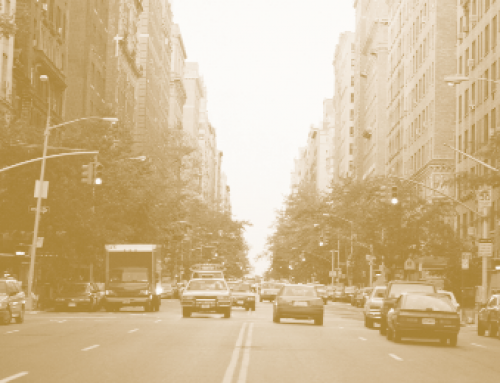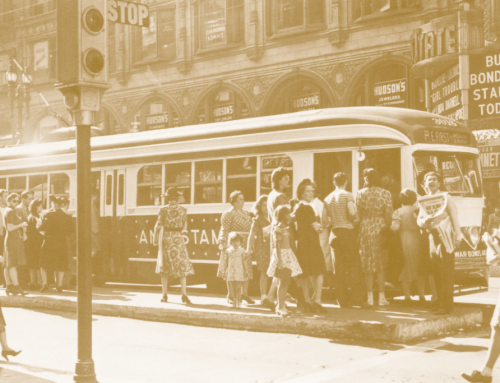The most transparent trend in metropolitan areas is the decentralization of jobs and housing into the suburbs and beyond. Scholars blame sprawl for many things, ranging from car-generated air pollution to commute-induced social alienation. But what do we know about its effects on travel behavior?
According to conventional wisdom, people are driving farther to work these days—but supporting evidence is thin. It’s not clear whether homes and jobs are growing farther apart or closer, nor which industries and occupations are dispersing most or least. Here we tackle one key unanswered question: How does job sprawl affect average commute length?
Explaining The Journey To Work
 According to classical urban theory, land is most expensive where firms most want to locate, and prices decline with distance from there. If firms all want to be in one place (let’s call it “downtown”), land (and housing) will tend to be cheaper in the suburbs, and many workers would commute from suburb to center. But what if jobs move out to the suburbs too, as indeed many have?
According to classical urban theory, land is most expensive where firms most want to locate, and prices decline with distance from there. If firms all want to be in one place (let’s call it “downtown”), land (and housing) will tend to be cheaper in the suburbs, and many workers would commute from suburb to center. But what if jobs move out to the suburbs too, as indeed many have?
When choosing a location, firms must balance the cost of land against the benefits of clustering, access to markets, and proximity to workers. For some firms, cheaper land and the presence of a labor pool outside the city center may outweigh the benefits of being near other businesses they deal with. According to this simple view, firms would decentralize in part to gain shorter commutes for their workers, expecting that to translate into reduced wage costs.
Of course, the real world cannot be explained by this simple theory. Consider three further complications.
First, workers are less likely to choose where to live based on job proximity if they know they’ll change jobs, if the location of their next job is uncertain due to job decentralization, or if their household has more than one worker. The choice becomes a gamble. Since it’s costly to move, workers may hedge their bets by locating at some intermediate spot, say somewhere between the city center and the suburbs, to reduce their long-range commute and moving costs. For households with two or more workers whose current and expected future jobs are in different places, finding a place to live near work may not even be possible. In either case, decentralization of jobs might increase commute distances.
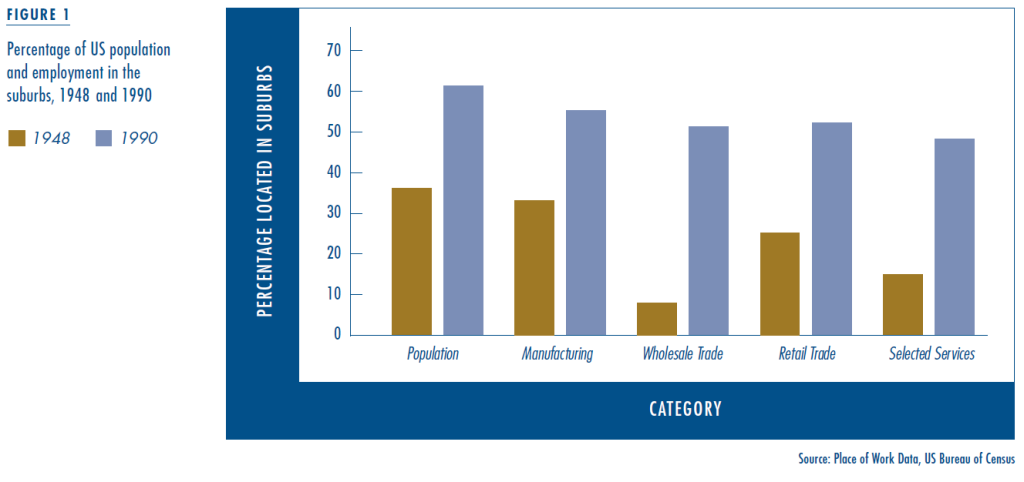 Second, firms may not choose to locate in suburbs solely to be near their work forces. They may enjoy other benefits from decentralization, including underused transportation capacity in outlying areas, better access to external markets, lower taxes, and proximity to suburban customers. If these factors are important, then job decentralization will not necessarily produce shorter commutes.
Second, firms may not choose to locate in suburbs solely to be near their work forces. They may enjoy other benefits from decentralization, including underused transportation capacity in outlying areas, better access to external markets, lower taxes, and proximity to suburban customers. If these factors are important, then job decentralization will not necessarily produce shorter commutes.
Third, households clearly think about more than just job location when choosing where to live. They also consider access to shopping and other nonwork activities, the quality of the neighborhood, schools, and other public services, and the resale value of the property (which reflects all of these). In general, the higher priority they give other considerations, the less likely it is that people will reduce commute length when firms decentralize.
So, in theory, sprawl might either lengthen or shorten the commute. To understand what happens in practice, we need to examine actual travel data.
Earlier Studies
Relatively little empirical work directly examines the influence of sprawl on commute distance or duration. One exception is an important county-level study published in the late 1980s by Peter Gordon, Ajay Kumar, and Harry Richardson, which looked at the amount of time involved in commutes. They found that commutes in spatially large cities took more time than in small cities, while quicker commutes were associated with higher proportions of industrial employment. High overall residential density and high shares of employment in the central city were both strongly associated with time-consuming commutes. The authors concluded that both residential and employment dispersion reduce commute duration.
Other research using data on individuals has found that decentralization lengthens the commute under some circumstances or for particular household groups. For example, in his UC Berkeley dissertation and subsequent research, Jonathan Levine found that commutes of low-income households increased in distance as employment suburbanized, in part due to shortages of affordable housing nearby. This finding raises a further complication: although land tends to be cheaper in the suburbs, regulations on the construction of higher density, cheaper housing units may reduce the available supply in many areas.
This line of research remains in its infancy. Behavioral data typically are either too aggregated or are limited in some other way, making it difficult to explore individual choices; and statistical models are insufficiently developed. Although empirical relationships may be too complex ever to be fully understood, it is certainly possible to understand them better.
Our Research
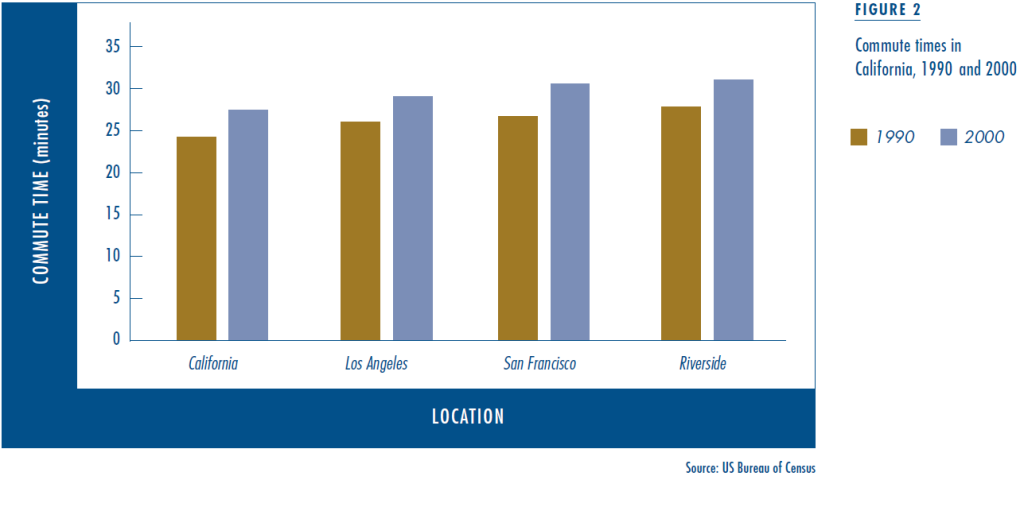 As it turns out, commute times have indeed risen in many metropolitan areas (Figure 2). Is job sprawl to blame? To find out, we need detailed data and appropriate analytical techniques that isolate the independent roles of numerous possible contributing factors.
As it turns out, commute times have indeed risen in many metropolitan areas (Figure 2). Is job sprawl to blame? To find out, we need detailed data and appropriate analytical techniques that isolate the independent roles of numerous possible contributing factors.
Below we explain our hypotheses, discuss the data we used, and analyze our results. Although we give few details here, our analytic model accounts for time trends, housing costs, and wages. For details on our methods, please refer to Further Reading at the end of this article.
Hypotheses
All things considered, commute duration should shrink as employment suburbanizes. A key trade-off for firms is between proximity to other firms and proximity to workers. Suburbanization of employment may indicate that firms are choosing the latter over the former, which should in turn translate into shorter commutes.
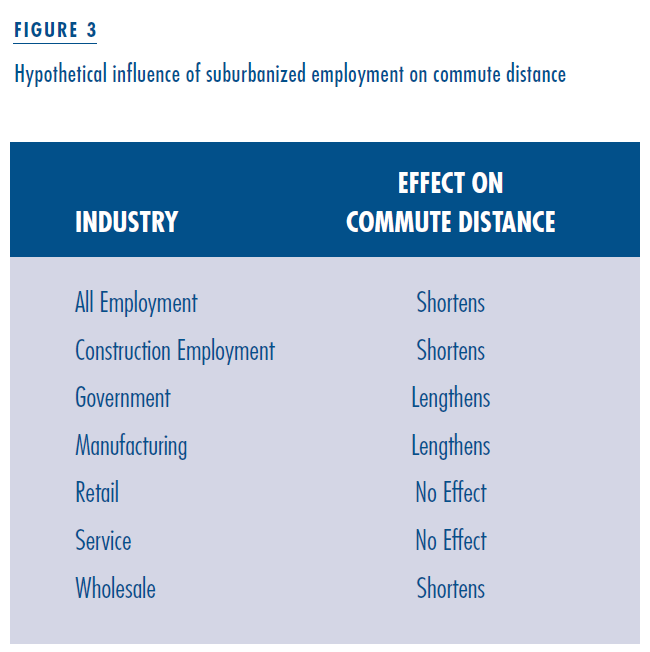 The commute should be longer for those with greater uncertainty about future job location or with high moving costs. Within a given city, the frequency of job relocation may be high for some occupations, such as construction workers, and low for others, such as university professors. Also, those with high expected moving costs tend to stay put in one place longer. Therefore, workers with high moving costs in high-turnover occupations would have longer commutes, everything else being equal.
The commute should be longer for those with greater uncertainty about future job location or with high moving costs. Within a given city, the frequency of job relocation may be high for some occupations, such as construction workers, and low for others, such as university professors. Also, those with high expected moving costs tend to stay put in one place longer. Therefore, workers with high moving costs in high-turnover occupations would have longer commutes, everything else being equal.
Benefits of decentralization may vary by industry. For example, decentralization of manufacturing jobs may be driven by the search for larger, cheaper land parcels. But the benefits of firm clustering may actually be increasing over time in such industries as software production, clothing design, and filmmaking. For such industries, any broad pattern of decentralization may actually be highly clustered, reducing the extent to which workers in that industry will locate nearby. Because the data we use are available with old-style Standard Industrial Classification codes, we can roughly test the idea that different kinds of business engage in different kinds of decentralization, and therefore have different effects on average commute distance.
Data
For information on individuals and their commute distances, we use data from 1985 to 1997 from the American Housing Survey (AHS), a large, nationwide survey administered every two years by the Census Bureau. The AHS samples most of its housing units repeatedly over time, with some replacements and additions.
We then merge the AHS data with metropolitan-level measures of employment suburbanization, calculated using county- level data from the US Bureau of Economic Analysis. We classify any county containing a city as part of the central urban area. Only employment in counties without large agglomerations or high density is designated as decentralized. This means that our definition of suburbanization is conservative, accounting for the fact that the urbanized portion of a metropolitan area may be polycentric or irregularly shaped. Thus, in one sense, our measure of job sprawl is more accurate than the typical measure of decentralization, namely distance from a single city center. In another sense the measure is somewhat crude, because it relies on county geography.
Results
 Using conventional economic models of travel demand, we investigated the commute distance of individual workers in combination with household characteristics and community factors, such as household income, size, race, education, and the population and geographic size of the metropolitan area. In many respects, commute time would be a better measure; the AHS, however, reports commute distance only over this period. The extent to which these two track each other depends mainly on congestion and the use of different modes, which in turn vary within a metropolitan area.
Using conventional economic models of travel demand, we investigated the commute distance of individual workers in combination with household characteristics and community factors, such as household income, size, race, education, and the population and geographic size of the metropolitan area. In many respects, commute time would be a better measure; the AHS, however, reports commute distance only over this period. The extent to which these two track each other depends mainly on congestion and the use of different modes, which in turn vary within a metropolitan area.
Surprisingly, despite all the potential complications, the results are largely consistent with our hypotheses (Figure 3). Taken by itself, job suburbanization shortens the average commute. A five percent increase in employment in a metropolitan area’s outlying counties is associated with a 1.5 percent reduction in average commute distance, if we control for other factors.
However, this is not the same as saying that commute distances got shorter. Other factors, for example rising incomes, lead to longer commutes. Also, there is a trend over time toward longer commutes that is explained by neither job sprawl nor other obvious factors, although it appears that job suburbanization has mitigated this increase. In other words, the average commute would be longer still if jobs were more centralized.
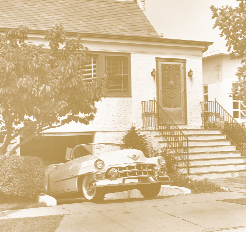 When suburban employment is broken out by industry, an interesting pattern emerges (Figure 3). Increased decentralization of construction and wholesale jobs reduces the average commute distance for workers in a given metropolitan area, while when manufacturing and government jobs decentralize, average commute distance grows. Retail and service jobs moving out to the suburbs do not appear to have much effect on commute length.
When suburban employment is broken out by industry, an interesting pattern emerges (Figure 3). Increased decentralization of construction and wholesale jobs reduces the average commute distance for workers in a given metropolitan area, while when manufacturing and government jobs decentralize, average commute distance grows. Retail and service jobs moving out to the suburbs do not appear to have much effect on commute length.
The pattern of firm clustering by industry on a county level may explain why decentralization of some kinds of employment increases commute distance. More clustering means less mixing of residential and nonresidential land uses, which increases commute distances compared to an entirely dispersed pattern. Construction and wholesale firm decentralization may be more dispersed than manufacturing and government employment, so people can more easily choose jobs near their homes (or homes near their jobs). Certain kinds of manufacturing (particularly, small firms in technologically advanced industries) may value being near other firms, and they decentralize for reasons other than to reduce the commutes of their workers. In this case manufacturing employment decentralization might occur in a more clustered fashion and/or in a way that does not follow the population pattern. Meanwhile, retail and service firms tend to cluster with each other, while the size of retail outlets has been increasing, so one might expect longer commutes due to reduced dispersion. But because such firms are population-serving, they tend to follow dispersed residential patterns in the metropolis they serve.
Another likely explanation has to do with the share of production costs accounted for by labor. Industries with a high ratio of labor to capital will have a strong incentive to decentralize so as to stay near their labor pools and keep labor costs down. Wholesale and construction employment are examples of this kind of industry, whereas of the classifications we use, manufacturing probably has the lowest ratio of labor to capital. Meanwhile, the government sector is a special case. The location of government facilities probably does not take wage costs into account when deciding where to locate, since other criteria are more important.
Do these results settle the question? No. Our conclusions are much too tentative. Although the panel nature of the AHS is particularly well suited to this analysis, the data unfortunately do not allow us to test the determinants of commute duration, because only commute distance information is available over the sample period. If traffic congestion is lower in suburban areas, jobs moving out to those areas might reduce average commute durations more than average commute distances.
We also have not fully explored the roles of multiple earners, uncertainty of job location, alternative measures of employment decentralization, or other competing explanations for where people choose to live relative to where they work. The results at this stage of the analysis are useful mainly to clarify the questions at hand and suggest how future research should proceed.
Closing Comments
Our new evidence supports the argument that, on average, decentralized employment reduces commute distance. Suburbanization of construction and wholesale jobs means commutes of shorter distance, although deconcentrated manufacturing and government jobs are associated with longer commutes. These differences by industry indicate the complexity of the relationships among the various factors including metropolitan characteristics, household dynamics, and the economics of travel, housing, and labor.
If job sprawl is not to blame, what does explain longer commutes—both longer distance, such as in our data, and longer duration over the past ten years in California as in Figure 2? Our analysis shows that rising incomes extend commute distances, and over this period household income increased by about eight percent in real terms in the US. Other factors not included in our analysis played their roles as well. Longer distance commutes may be explained by the increasing numbers of two-worker households, or by households focusing more on school quality than on job location when deciding where to live. And commutes of longer duration due to increased traffic congestion might be expected as urban areas gain population without adding new roads. These hypotheses deserve further exploration in future research. Our early analysis treats but a small piece of a much bigger puzzle.
Further Readings
Randall Crane, “The Influence of Uncertain Job Location on Urban Form and the Journey to Work,” Journal of Urban Economics, no. 39, pp. 342–356, 1996.
Randall Crane and Daniel Chatman, “Traffic and Sprawl: Evidence from US Commuting, 1985–1997,” forthcoming in Christine Bae and Harry Richardson, eds., Urban Sprawl in Western Europe and the United States, Ashgate, 2003, and in Planning and Markets, 2004.
Edward Glaeser and Matthew Kahn, “Decentralized Employment and the Transformation of the American City,” in Dennis Gale and Janice Pack, eds., Papers on Urban Affairs (Washington, Brookings Institution Press, 2001).
Peter Gordon, Ajay Kumar, and Harry Richardson, “The Influence of Metropolitan Spatial Structure on Commuting Time,” Journal of Urban Economics, no. 26, pp. 138–151, 1989.
Jonathan Levine, “Employment Suburbanization and the Journey to Work,” PhD Dissertation, Department of City and Regional Planning, UC Berkeley, 1990.
William C. Wheaton, Commuting, Ricardian Rent and Housing Appreciation in Cities with Dispersed Employment and Mixed Land-Use (MIT: Department of Economics and Center for Real Estate, 2002.)





